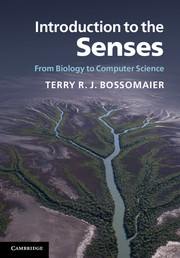Book contents
- Frontmatter
- Contents
- Foreword
- Acknowledgements
- 1 Introduction and overview
- 2 Understanding sensory systems
- 3 Introduction to Fourier theory
- 4 Introduction to information theory
- 5 Hearing
- 6 Basic strategies of vision
- 7 The correspondence problem: stereoscopic vision, binaural hearing and movement
- 8 The properties of surfaces: colour and texture
- 9 The chemical senses
- 10 The somatosensory system
- 11 Non-human sensory systems
- 12 Sensory integration
- References
- Index
- Plate section
5 - Hearing
Published online by Cambridge University Press: 05 July 2012
- Frontmatter
- Contents
- Foreword
- Acknowledgements
- 1 Introduction and overview
- 2 Understanding sensory systems
- 3 Introduction to Fourier theory
- 4 Introduction to information theory
- 5 Hearing
- 6 Basic strategies of vision
- 7 The correspondence problem: stereoscopic vision, binaural hearing and movement
- 8 The properties of surfaces: colour and texture
- 9 The chemical senses
- 10 The somatosensory system
- 11 Non-human sensory systems
- 12 Sensory integration
- References
- Index
- Plate section
Summary
Tones sound, and roar and storm about me until I have set them down in notes.
Ludwig van BeethovenVision is the sense with the greatest bandwidth, but our sense of hearing provides distinctive, equally vital information. Apart from communication through speech, tone voice conveys a full gamut of emotions. Moreover sound, with quite different properties to light, carries quite different environmental information, and is less directional than vision.
Human hearing is good, but by no means the most sensitive within the animal kingdom, or that with the greatest frequency range. But again, animals get very close to the limits imposed by physics. As computing power and miniaturisation have grown dramatically in the last decade, knowledge of hearing has become essential to determining the standards for the capture and storage of audio information from telephone conversations to games. In 2010 the directional information from sound is still not very well captured and utilised in artificial systems. Chapter 7 covers the processing of directional information.
Having got the theoretical building blocks behind us, sound is a good place to start in the study of the senses themselves. It embodies all the ideas of the chapters on information theory and Fourier Analysis, but, being one-dimensional, is somewhat simpler than vision. Moreover, the idea of frequency in sound is commonplace, and thus easier to discuss, whereas spatial frequency in vision is a less everyday concept.
But whereas the theoretical framework of Fourier Analysis is pivotal to understanding vision and hearing, the sonic transduction elements have a great deal in common with touch and we shall come back to them in Chapter 10. In fact these transduction elements are some of the oldest in evolution.
- Type
- Chapter
- Information
- Introduction to the SensesFrom Biology to Computer Science, pp. 92 - 123Publisher: Cambridge University PressPrint publication year: 2012

